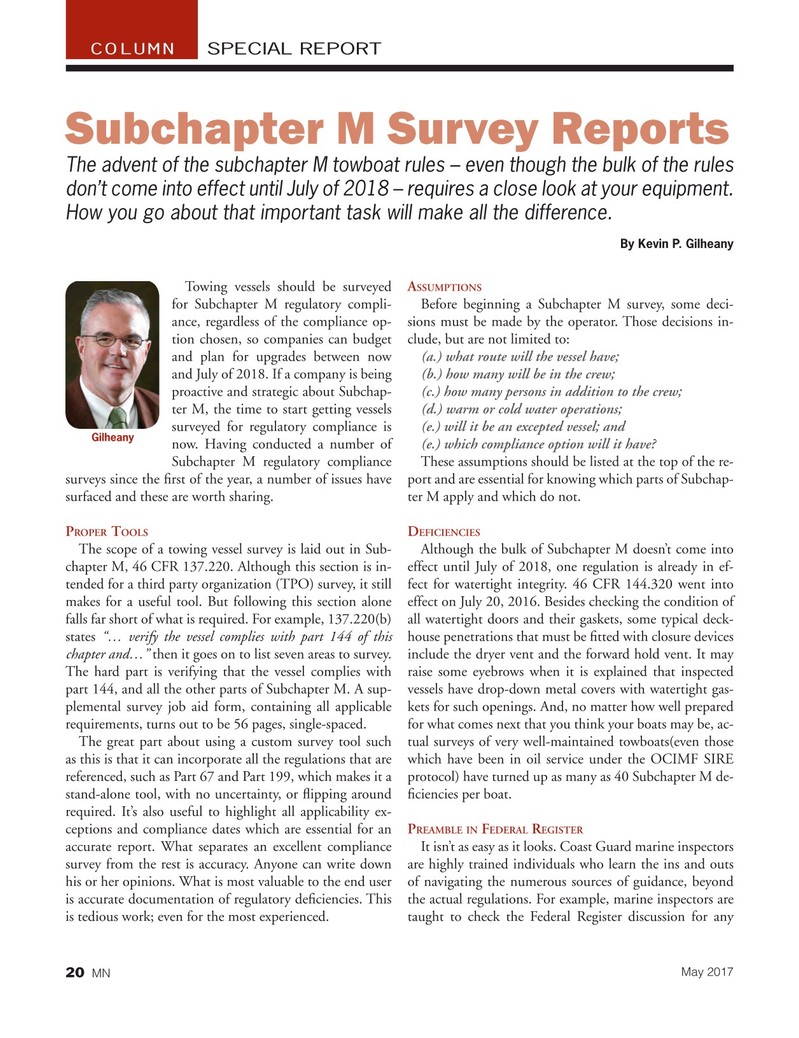
Page 20: of Marine News Magazine (May 2017)
Inland Waterways
Read this page in Pdf, Flash or Html5 edition of May 2017 Marine News Magazine
COLUMN SPECIAL REPORT
Subchapter M Survey Reports
The advent of the subchapter M towboat rules – even though the bulk of the rules don’t come into effect until July of 2018 – requires a close look at your equipment.
How you go about that important task will make all the difference.
By Kevin P. Gilheany
SSUMPTIONS
Towing vessels should be surveyed A for Subchapter M regulatory compli- Before beginning a Subchapter M survey, some deci- ance, regardless of the compliance op- sions must be made by the operator. Those decisions in- tion chosen, so companies can budget clude, but are not limited to: and plan for upgrades between now (a.) what route will the vessel have; and July of 2018. If a company is being (b.) how many will be in the crew; proactive and strategic about Subchap- (c.) how many persons in addition to the crew; ter M, the time to start getting vessels (d.) warm or cold water operations; surveyed for regulatory compliance is (e.) will it be an excepted vessel; and
Gilheany now. Having conducted a number of (e.) which compliance option will it have?
Subchapter M regulatory compliance These assumptions should be listed at the top of the re- surveys since the ? rst of the year, a number of issues have port and are essential for knowing which parts of Subchap- surfaced and these are worth sharing. ter M apply and which do not.
ROPER OOLS EFICIENCIES
P T D
The scope of a towing vessel survey is laid out in Sub- Although the bulk of Subchapter M doesn’t come into chapter M, 46 CFR 137.220. Although this section is in- effect until July of 2018, one regulation is already in ef- tended for a third party organization (TPO) survey, it still fect for watertight integrity. 46 CFR 144.320 went into makes for a useful tool. But following this section alone effect on July 20, 2016. Besides checking the condition of falls far short of what is required. For example, 137.220(b) all watertight doors and their gaskets, some typical deck- states “… verify the vessel complies with part 144 of this house penetrations that must be ? tted with closure devices chapter and…” then it goes on to list seven areas to survey. include the dryer vent and the forward hold vent. It may
The hard part is verifying that the vessel complies with raise some eyebrows when it is explained that inspected part 144, and all the other parts of Subchapter M. A sup- vessels have drop-down metal covers with watertight gas- plemental survey job aid form, containing all applicable kets for such openings. And, no matter how well prepared requirements, turns out to be 56 pages, single-spaced. for what comes next that you think your boats may be, ac-
The great part about using a custom survey tool such tual surveys of very well-maintained towboats(even those as this is that it can incorporate all the regulations that are which have been in oil service under the OCIMF SIRE referenced, such as Part 67 and Part 199, which makes it a protocol) have turned up as many as 40 Subchapter M de- stand-alone tool, with no uncertainty, or ? ipping around ? ciencies per boat.
required. It’s also useful to highlight all applicability ex- ceptions and compliance dates which are essential for an P F R
REAMBLE IN EDERAL EGISTER accurate report. What separates an excellent compliance It isn’t as easy as it looks. Coast Guard marine inspectors survey from the rest is accuracy. Anyone can write down are highly trained individuals who learn the ins and outs his or her opinions. What is most valuable to the end user of navigating the numerous sources of guidance, beyond is accurate documentation of regulatory de? ciencies. This the actual regulations. For example, marine inspectors are is tedious work; even for the most experienced. taught to check the Federal Register discussion for any
May 2017 20
MN

 19
19

 21
21
